Our Best Guide To Buying a Turbo Trainer & How They Work
Contents
- 1 Our Best Guide To Buying a Turbo Trainer & How They Work
- 1.1 What Is a Turbo Trainer & How Do They Work?
- 1.2 What Are The Main Types Of Turbo Trainers?
- 1.3 What Are Smart Turbo Trainers?
- 1.4 Are There Benefits To Using a Turbo Trainer?
- 1.5 Disadvantages Of Using a Turbo Trainer
- 1.6 Top Tips For Using a Turbo Trainer
- 1.7 Frequently Asked Questions About Turbo Trainers & How They Work
- 1.8 Last Words
If you have decided you don’t want to let your fitness levels dip this winter and you want to be able to use your bike during any kind of weather, or maybe you need to be able to fit in late-night cycling sessions, then you’ve probably been thinking about investing in a turbo trainer.
Turbo trainers can be a little overwhelming if it is your first time looking into them, from smart trainers to rollers, it can be difficult to understand how these devices work. So to put it in simple terms, a turbo trainer is a static resistance machine that allows you to attach your bike and provide resistance, making you feel and cycle as if you were riding a real-life bike.
These turbo trainers work in different ways depending on the type of trainer you buy as there resistance mechanisms vary, but most can be used with any kind of mountain bike or road bike as long it fits the size and requirements of your bike.
So to understand turbo trainers further and how they work, we have put together an extensive guide that should tell you everything you need to know about these trainers, as well as how to buy the best one possible.
Let’s get into it!
What Is a Turbo Trainer & How Do They Work?
Before we can get on to how turbo trainers work, we need to understand what one is.
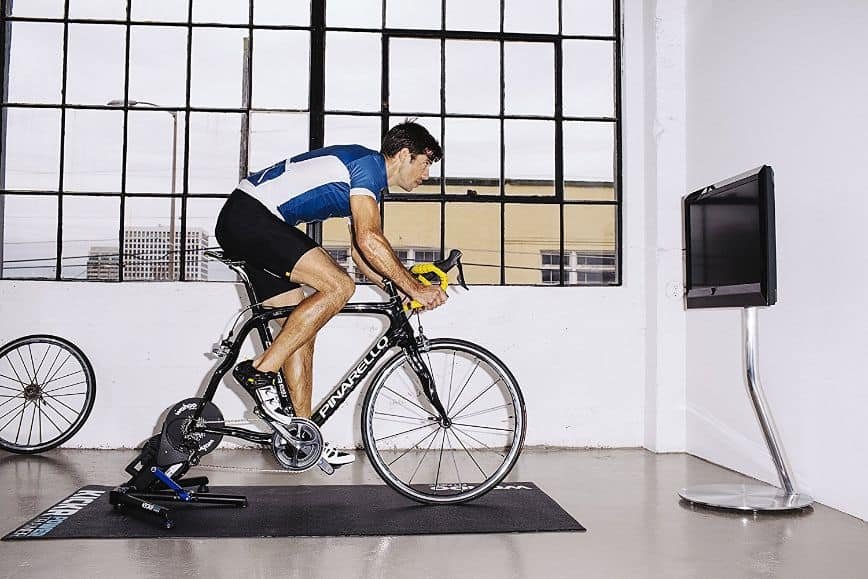
So let’s start with the basics as we touched on briefly above, a turbo trainer is a static machine to which you can attach your bike too. Most of these trainers allow you to keep the rear wheel of your bike stable and some have rollers to generate resistance while you are riding the bike.
The resistance of this bike can typically be varied according to how much you pedal or a lever, which will get on to later.
What Are The Main Types Of Turbo Trainers?
To understand how turbo trainers work, we need to know the different types on the market and how their resistance operates.
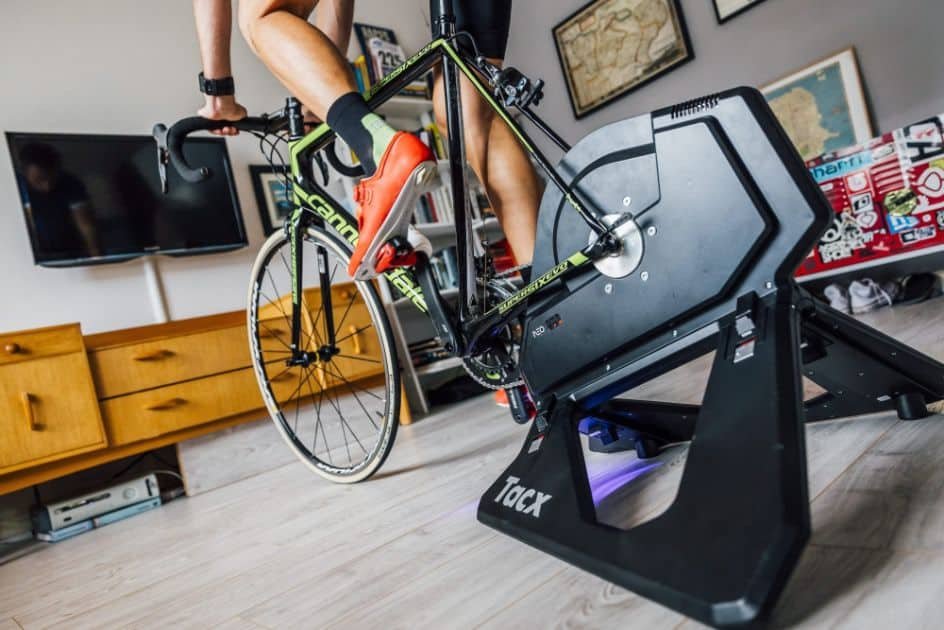
There are four main types of turbo trainers on the market; wheel-on trainers which vary with magnetic and fluid resistance (we will spilt that into two types to make it easier to understand), direct-drive trainers and roller trainers.
We have gone into more detail about each type of trainer below with there advantages and disadvantages so as you can figure out which type of turbo trainer is right for you and your bike.
Fluid Wheel On Bike Trainers
To begin with, let’s start with wheel-on bike trainers which come with either fluid or magnetic resistance.

Fluid trainers use a roller and a flywheel to operate, the exterior shell of a fluid trainer heats up as you pedal, so the faster you pedal on this trainer the more resistance is created, making it harder. No adjustments are needed on this kind of trainer and the resistance has a real-life-like feel to it due to the way it gradually changes and continues to move even without pedalling.
These wheel-on fluid trainers will have the rear wheel of your bike attached to the trainer on the roller to create resistance and are much more lightweight and easy to transport than other trainers.
We have listed out the pros and cons of these fluid style turbo wheel-on trainers below.
Pros
- Realistic ride feel – Fluid wheel turbo trainers are the most life-like trainers out there due to the way there resistance operates, but also because of there WATT metres which allow you to measure how much effort you are putting in distance wise.
- Very quiet – Due to the way fluid trainers work, this liquid mechanism does not make as much noise as other trainers, making it more indoor friendly.
- Does not let you overpower – Fluid resistance will never let you overpower it, meaning the resistance will always be getting more difficult the harder that you pedal, allowing your fitness to grow along with the bike.
Cons
- Fluid can leak – There is a possibility on these wheel-on fluid trainers that the fluid can leak, this can happen as the temperature changes, allowing the seal to break on the machine.
- Not compatible with thru-axles – If you want to use this type of trainer with an MTB bike then you would need to purchase an extra part as they are not compatible with thru-axle bikes.
- Expensive – Fluid resistance on-wheel turbo trainers are more expensive than other resistance types due to their natural feel, so you would need to weigh up whether this is worth the investment.
Magnetic Resistance Trainers
You can find magnetic resistance on-wheel bike trainers too, this resistance operates with the magnetic flywheel which generates resistance as it gets turned by the bike. Magnetic resistance trainers are normally adjusted by a lever, meaning you would have to get off the bike or use the lever on the handlebars and set your chosen resistance level before riding the bike.
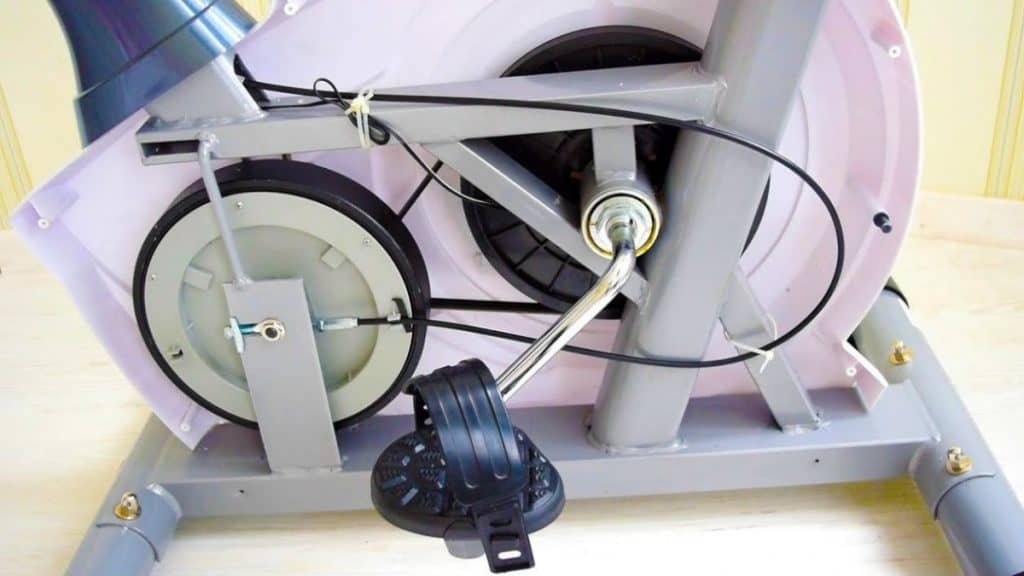
Pros
- On-the-wheel trainers are more portable – These types of trainers, whether fluid or magnetic are much more portable and lightweight, making them easy to store away or even travel with.
- They are budget-friendly – Magnetic resistance is much more affordable than fluid, allowing beginners who aren’t sure about turbo trainers to give them a try without spending too much money.
- Can have a great ride quality – If you go for a higher-end magnetic resistance trainer, this can mirror training on an exercise bike and be a great tool for improving and testing your fitness with some even offering progressive resistance.
Cons
- It’s not very life-like – In comparison to other turbo trainers, this type of resistance is not very life-like due to the constant set level of resistance and halting as soon as you stop pedalling on the bike.
- Changing the resistance is awkward – If your magnetic resistance trainer needs to be adjusted off your bike, this can make it difficult to change the intensity of your workout while riding.
- They are noisy – Due to the mechanism of magnetic resistance, it is very noisy and can be loud to use inside of your home.
Direct Drive Trainers
Direct drive turbo trainers are one of the newest models on the market and operate without the need for your rear wheel on your bike as the trainer will take its place.

These types of trainers tend to always come with smart software and are the best for giving a smooth and stable life-like riding experience, they are also low in noise and are known for having a more accurate power reading which is great for tracking your cycling.
They work with a cassette attached to them, using a heavy flywheel to create momentum, allowing you to avoid having to purchase a spare tyre for the trainer.
Pros
- High accuracy – Direct drive trainers are extremely accurate in how they operate when compared to fluid and magnetic trainers and can measure accuracy up to -/+ 3%.
- Easy set-up – No rear wheel needs to be fitted to use this trainer, making it less faff to attach and hop on.
- Realistic – The heavy flywheel of these models makes them life-like and stable, they also have less chance of any rear-wheel slipping as they use there cassette.
Cons
- Very expensive – Although you may eliminate the need to buy an extra tyre and wheel, these types of new smart trainers do not come cheap and can go up to prices of £1000.
- Not storage-friendly – Due to the way these direct driver turbo trainers operate, their flywheel makes them very heavy, meaning they are less easy to store and move around in comparison to other kinds of trainers.
Roller Trainers
Roller trainers tend to be the more simple and cost-effective type of trainer in comparison to others, no rear wheel change is needed for this trainer and the wear on your tyres is not as harsh.
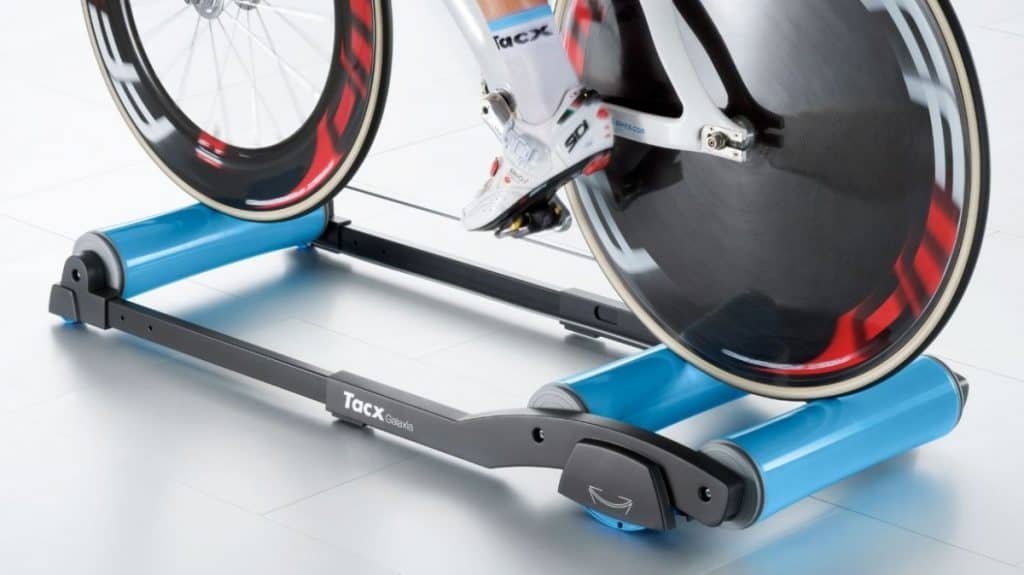
This trainer works by simply placing your bike on top of three rollers or ‘drums’ which sit on top of a regular frame. The rear wheel of your bike turns the back rollers so that the front roller can turn, meaning you need to keep your bike balanced while you ride it as you would in real life. These roller trainers are harder to use than turbo as they require more balance, but do have a set level of resistance which can be limiting.
Pros
- Great for improving balance – Unlike wheel-on trainers, the balance of the bike on top of these rollers is determined by you and how you handle the bike, much like real-life riding.
- Easy to use – Roller trainers mean you simply place your bike on top of the machine for them to work, meaning there is no setting resistance or removing the wheel of your bike, making them ideal for quick warm-ups and warm downs too!
- Budget-friendly – These types of trainers are not complicated, so their price is very budget-friendly and can be a great option for indoor cycling workouts now and then.
Cons
- No varying resistance level – Unfortunately, on roller trainers, you cannot change the resistance, meaning you are stuck with only one level of difficulty.
- Much harder to do interval training on – Because of the way your bike will sit on these rollers, doing sprints and high interval training can be very hard if you are not used to riding a bike on these roller trainers.
What Are Smart Turbo Trainers?
Now we have covered the main types of turbo trainers on the market and there different kinds of resistance, you might be wondering what a ‘smart’ trainer is and how they work.
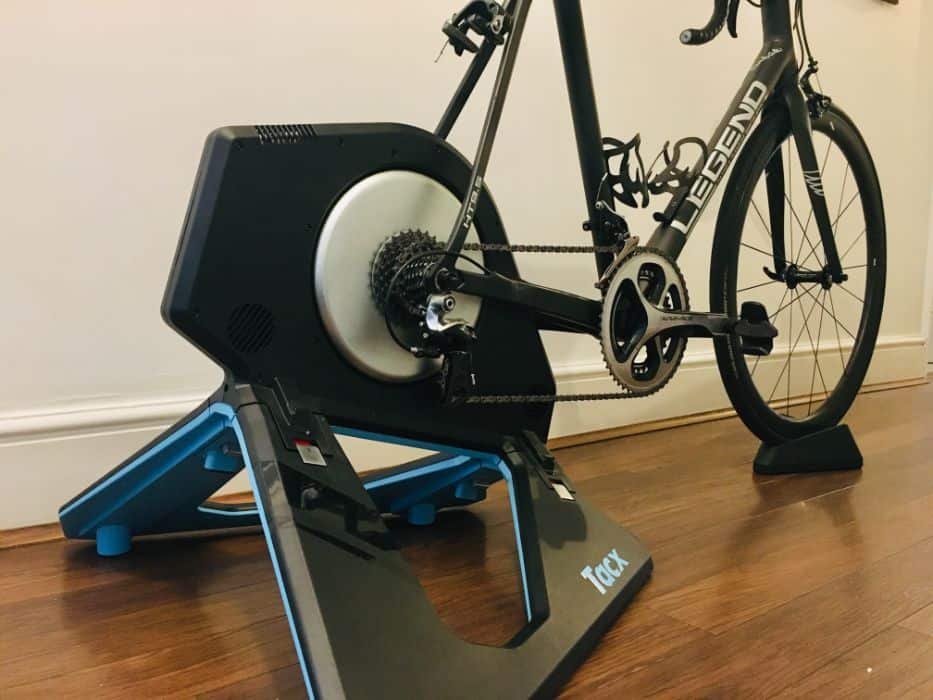
Smart trainers are the same as normal turbo trainers except they are interactive, meaning they come with software that can replicate hill resistance and different terrains, as well as taking you through different kinds of workouts, letting you ride your bike in a virtual world, and making indoor cycling much less boring.
The software for these trainers tends to be apps such as Swift or RGT cycling and work by using Bluetooth to sync your devices together, they also provide very accurate training data as you cycle, allowing you to monitor and progress with your fitness every time you use the trainer.
Are There Benefits To Using a Turbo Trainer?
If you still on the edge about whether a turbo trainer is for you or not, then learning about the advantages and disadvantages of these trainers can help you figure out if they are. For example, turbo trainers allow you to exercise with your bike in all types of weather conditions, meaning you can maintain your fitness level and even progress over the winter.

We have listed out a few more advantages below.
- You can use your bike at night – Night riding outside is not for everyone, and sometimes life can get in the way and force us to cycle at night, turbo trainers allow you to get that cycling session in without having to venture out on to the roads during the dark.
- They allow you to vary resistance – Turbo trainers let you improve your fitness by varying resistance, meaning you can progress and have a life-like ride with your bike similar to riding on hills outside.
- Great for practising technique – Due to fewer distractions, turbo trainers allow you to zone in on your technique, meaning you can check things such as your posture which you would usually forget about while you are cycling outside.
- Saves space – Rather than buying a separate exercise bike, using your bike on these trainers prevents you from having to find somewhere to store two different bikes, giving you more space.
- Allows you to get used to your bike – Rather than working out on an exercise bike, using a turbo trainer means you can get better on your bike without having to readjust your posture constantly or ride with two different bikes.
- Time-efficient – Indoor cycling on a turbo trainer allows you to avoid freecycling and keeps you moving on the pedals nearly all of the time that you are on the bike, meaning around one hour on a turbo trainer is equal to nearly 3 hours on the road when you compare, allowing you to get the same kind of workout in but within a shorter time.
- You can train in all kinds of weather – No matter whether it is torrential rain or snow, a turbo trainer lets you cycle on your bike no matter the weather.
Disadvantages Of Using a Turbo Trainer
- You will have to buy another tyre – Due to the friction of the rollers on these trainers against the tyre of your bike, they will wear them down quickly, meaning you will have to buy a separate special tyre for your bike or a spare road bike tyre depending on the training you will be doing and the trainer that you buy.
- They can be noisy – These trainers tend to be very noisy sometimes due to the way that their mechanisms operate, meaning you will have to adjust to having the noisy trainer inside.
- Not as life-like – Unless you buy expensive trainers such as the direct driver trainers or on-wheel fluid trainers, magnetic resistance models tend to not be very life-like, meaning you might end up having a less exciting ride than you would outside.
- They can get boring – Unfortunately, if your trainer is not a smart trainer you might find the riding experience very boring as there is no external environment to look at and pass time.
Top Tips For Using a Turbo Trainer
To use your turbo trainer in the best way possible, we have put together some tips that can help you get the most out of your indoor cycling, whether you are advanced in cycling or a beginner, these tips should help you out.

- Fuel yourself – Working out on a turbo trainer is not easy and very high intensity, you need to fuel yourself properly before undertaking exercise like this with energy bars or carbohydrates.
- Make sure you are set-up properly – Ensure you have a full water bottle and a yoga mat under your bike to catch any sweat, allowing yourself to be set-up properly can reduce the chance of you having to interrupt your workout.
- Keep yourself cool – Having a fan on hand can make your cycling session more bearable as this high cardio workout can make you very hot and sweaty!
- Know your maximum heart rate – Once you know your maximum heart rate, you can effectively see when you are working the hardest on your bike, allowing you to push yourself further during workouts.
- Get a smart trainer – If your going to invest in a turbo trainer, you may as well invest in a smart one as this can make your training much more interactive and exciting.
- Figure out what works for you – Whether you are into spin classes, HIIT workouts or long-distance cycling, it’s a good idea to try a variety of different cycling workouts on your bike so as you can see what style suits you best and enjoy using your turbo trainer.
Frequently Asked Questions About Turbo Trainers & How They Work
Will a turbo trainer work with any bike?
Yes, a turbo trainer can pretty much work with any kind of bike as long as it fits, the only thing you may need to adjust is the tyre and the thru-axle if you have a mountain bike.
Is it better to use rollers or on wheel turbo trainers?
This depends on your budget and level of cycling fitness. For people who have good balance and handling when they cycle, roller trainers might be a more budget-friendly option for cycling indoors, on-wheel trainers however allow you to vary resistance, making them a better option if you have a higher budget and want to push your fitness level.
Can I use a turbo trainer as a beginner?
Anyone can use a turbo trainer, as long you can change the resistance and make it right for your fitness level. We recommend a direct drive or fluid resistance trainers for the best varying training options.

Last Words
To conclude our turbo trainer guide, turbo trainers are a great way to continue with your cycling routine during the winter months or throughout bad weather, they also make a great option in comparison to normal exercise bikes as they allow you to still use your bike to workout on rather than two separate ones.
Just make sure the resistance type is suitable for your fitness level and type of bike, then your good to go!
